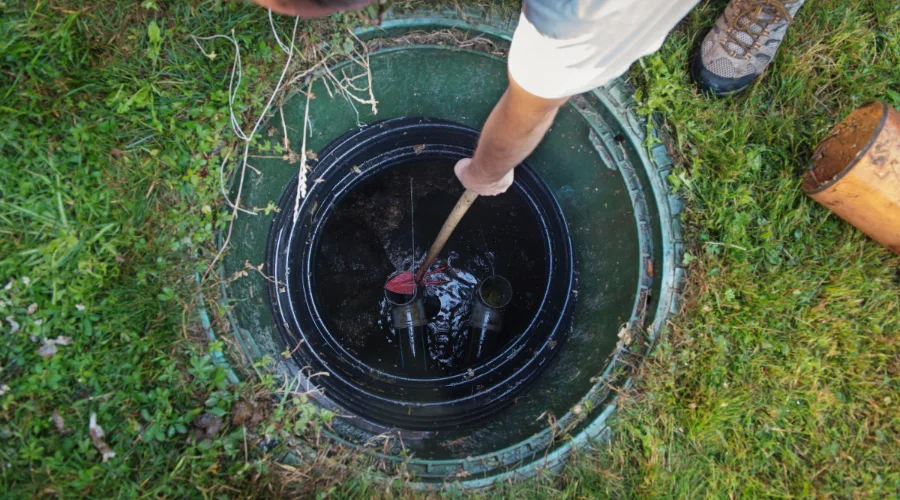Septic tanks are vital in the disposal of human waste and wastewater in areas without a centralized sewer system. They treat household wastes through natural processes. A properly designed tank ensures maximum efficiency, prolonged life, and minimum environmental side effects. This blog takes an in-depth look, with an aim to understand the septic tank, its components, requirements, functioning, and everything that you need to know about the septic tank.
Key Components of a Septic Tank
Inlet Pipe
The inlet pipe is a type of pipe through which wastewater enters the septic tank from your home. It drains waste from the household plumbing system into the tank. This piping system requires proper alignment and sealing to avoid leakage, allowing smooth flow of sewage water into the tank.
Outlet Pipe
The outlet pipe is a pipe where the treated wastewater is drained out of the septic tank towards the drain field or soak pit. This system should be designed in a way that only partially treated effluent is released after the primary treatment process.
Manhole

The manhole provides access to the septic tank for maintenance, inspection, and cleaning. It is a crucial component for the periodic pumping of waste and other repair requirements for effective flow.
Liquid Retention Tank
This large portion is the main body of the septic tank, where wastewater is deposited. The solids are settles at the bottom, while the oils and grease float on the surface, forming a scum. The liquid portion between the two is treated and filtered before drained out through the outlet pipe.
Baffle Wall
The baffle wall plays a major role in controlling the overall function of the septic tank. It keeps the inlet and outlet pipe appropriately in a way that only the effluent liquid waste is drained out, retaining the solids and scum inside the tank.
Soak Pit
The soak pit, also called as drain field, is a perforated structure that is specially designed to filter effluents before draining out to the ground. It ensures further treatment, letting the bacteria and soil break down remaining contaminants. These pits should be placed away from water sources to avoid contamination.
Vent Pipe
The vent pipe allows gases formed in the septic tank to discharge safely into the atmosphere. The vent pipe should be properly designed to maintain the operational efficiency of the tank, to avoid the forming of harmful gases like methane.
Factors To Consider in Septic Tank Design
Floor Area
The floor area of septic tanks is the major determinant of the capacity and efficiency of the septic tank. Larger floor areas enable the settling of higher amounts of solids, thus improving filtration. It is advisable to change the size of the tank according to the waste load expected to be generated.
Capacity
The capacity of the septic tank must be adequate enough to accommodate the waste generated by the household. The capacity is usually denoted in gallons or liters. Factors such as the number of persons in the household and the patterns of use are indications for determining the required capacity.
Depth and Volume
Depth and volume are crucial for a septic tank. They ensure the proper retention time for waste treatment. An appropriate depth in a tank would allow solids to settle in it. The volume of the tank ensures that the liquid waste is retained long enough to be treated properly.
Ventilation
Ventilation helps in releasing the gases trapped inside the tank and potential pressure build up. It is necessary to maintain proper ventilation as it helps in maintaining an environment and preventing blockages.
Principle of Septic Tank Design
The inlet pipe transports wastewater from the house to the septic tank. The septic tank holds the wastewater for a long time and separates the solid and liquid wastes.
After some time, the collected waste starts to separate into 3 layers.
- The upper layer consists of oil and grease and floats above all the waste, which is commonly terms as scum.
- The middle layer is a mixture of wastewater and waste particles.
- The third and bottom layer consists of solid particles that settle down to form sludge.
The bacteria inside the septic tank starts to break down solid waste, allowing the waste to separate, making it easy to drain. After the wastewater is separated, the outlet pipe or drain field moves the pre-treated effluents from the septic tank and disperses it evenly through soil and waterways. The permanent residue at the bottom of the tank should be pumped out regularly while undergoing maintenance.
Construction Materials and Installation
Construction Materials
- Concrete
- Brick
- Fiber Reinforced Plastic
- High-Density Plastic
Installation Process
- Preparation of site: Assess the site, that it has adequate space and soil support to hold the septic tank. Excavate the soil of sufficient dimension to fit the tank and the pipes.
- Tank Placement: Lower the tank into the excavated hole carefully, without tilting and connect them to the inlet and the outlet pipes.
- Pipe Connections: Connect the inlet pipe from the household plumbing to the tank and outlet pipe leading toward the soak pit or drainfield. Check for proper alignment to avoid blockages and leaks.
- Backfilling: Once the tank has been set into place, backfill the hole with soil by compacting it to stabilize the tank and prevent unnecessary movement.
- Ventilation: Install the ventilation pipe at the highest point of the tank to release gases into the atmosphere safely.
- Final Inspection: Conduct an in-depth inspection to ensure that each and every component is installed correctly and is functioning effectively.
Conclusion
In conclusion, a well-designed septic tank is necessary for the proper treatment of wastewater and environmental protection. The homeowners and engineers must consider the right materials, dimensions, capacity, and maintenance so that the system can last indefinitely. A well-designed septic tank works toward the efficient disposal of wastewater and a cleaner environment.

